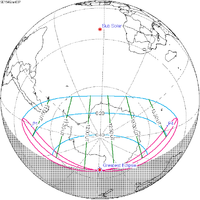| Total eclipse | |||||||||||||||||
 The Moon's hourly motion shown right to left The Moon's hourly motion shown right to left | |||||||||||||||||
| Date | December 19, 1945 | ||||||||||||||||
|---|---|---|---|---|---|---|---|---|---|---|---|---|---|---|---|---|---|
| Gamma | −0.2845 | ||||||||||||||||
| Magnitude | 1.3424 | ||||||||||||||||
| Saros cycle | 124 (45 of 74) | ||||||||||||||||
| Totality | 78 minutes, 53 seconds | ||||||||||||||||
| Partiality | 204 minutes, 54 seconds | ||||||||||||||||
| Penumbral | 320 minutes, 52 seconds | ||||||||||||||||
| |||||||||||||||||
| ← June 1945June 1946 → | |||||||||||||||||
A total lunar eclipse occurred at the Moon’s ascending node of orbit on Wednesday, December 19, 1945, with an umbral magnitude of 1.3424. A lunar eclipse occurs when the Moon moves into the Earth's shadow, causing the Moon to be darkened. A total lunar eclipse occurs when the Moon's near side entirely passes into the Earth's umbral shadow. Unlike a solar eclipse, which can only be viewed from a relatively small area of the world, a lunar eclipse may be viewed from anywhere on the night side of Earth. A total lunar eclipse can last up to nearly two hours, while a total solar eclipse lasts only a few minutes at any given place, because the Moon's shadow is smaller. Occurring about 1.6 days after perigee (on December 17, 1945, at 12:40 UTC), the Moon's apparent diameter was larger.
This lunar eclipse was the second of an almost tetrad, with the others being on June 25, 1945 (partial); June 14, 1946 (total); and December 8, 1946 (total).
Visibility
The eclipse was completely visible over much of North and South America, west Africa, Europe, and northern Russia, seen rising over the eastern Pacific Ocean and setting over east and southern Africa and much of Asia.
 
|
Eclipse details
Shown below is a table displaying details about this particular solar eclipse. It describes various parameters pertaining to this eclipse.
| Parameter | Value |
|---|---|
| Penumbral Magnitude | 2.32932 |
| Umbral Magnitude | 1.34237 |
| Gamma | −0.28453 |
| Sun Right Ascension | 17h46m11.1s |
| Sun Declination | -23°24'29.1" |
| Sun Semi-Diameter | 16'15.4" |
| Sun Equatorial Horizontal Parallax | 08.9" |
| Moon Right Ascension | 05h46m20.2s |
| Moon Declination | +23°07'25.0" |
| Moon Semi-Diameter | 16'28.3" |
| Moon Equatorial Horizontal Parallax | 1°00'27.1" |
| ΔT | 27.3 s |
Eclipse season
See also: Eclipse cycleThis eclipse is part of an eclipse season, a period, roughly every six months, when eclipses occur. Only two (or occasionally three) eclipse seasons occur each year, and each season lasts about 35 days and repeats just short of six months (173 days) later; thus two full eclipse seasons always occur each year. Either two or three eclipses happen each eclipse season. In the sequence below, each eclipse is separated by a fortnight.
| December 19 Ascending node (full moon) |
January 3 Descending node (new moon) |
|---|---|
 |

|
| Total lunar eclipse Lunar Saros 124 |
Partial solar eclipse Solar Saros 150 |
Related eclipses
Eclipses in 1945
- An annular solar eclipse on January 14.
- A partial lunar eclipse on June 25.
- A total solar eclipse on July 9.
- A total lunar eclipse on December 19.
Metonic
- Preceded by: Lunar eclipse of March 3, 1942
- Followed by: Lunar eclipse of October 7, 1949
Tzolkinex
- Preceded by: Lunar eclipse of November 7, 1938
- Followed by: Lunar eclipse of January 29, 1953
Half-Saros
- Preceded by: Solar eclipse of December 13, 1936
- Followed by: Solar eclipse of December 25, 1954
Tritos
- Preceded by: Lunar eclipse of January 19, 1935
- Followed by: Lunar eclipse of November 18, 1956
Lunar Saros 124
- Preceded by: Lunar eclipse of December 8, 1927
- Followed by: Lunar eclipse of December 30, 1963
Inex
- Preceded by: Lunar eclipse of January 8, 1917
- Followed by: Lunar eclipse of November 29, 1974
Triad
- Preceded by: Lunar eclipse of February 17, 1859
- Followed by: Lunar eclipse of October 18, 2032
Lunar eclipses of 1944–1947
| Descending node | Ascending node | |||||
|---|---|---|---|---|---|---|
| Saros | Date viewing |
Type chart |
Saros | Date viewing |
Type chart | |
| 109 | 1944 Jul 06
|
Penumbral
|
114 | 1944 Dec 29
|
Penumbral
| |
| 119 | 1945 Jun 25
|
Partial
|
124 | 1945 Dec 19
|
Total
| |
| 129 | 1946 Jun 14
|
Total
|
134 | 1946 Dec 08
|
Total
| |
| 139 | 1947 Jun 03
|
Partial
|
144 | 1947 Nov 28
|
Penumbral
| |
Saros 124
It was part of Saros series 124.
Half-Saros cycle
A lunar eclipse will be preceded and followed by solar eclipses by 9 years and 5.5 days (a half saros). This lunar eclipse is related to two total solar eclipses of Solar Saros 131.
| December 13, 1936 | December 25, 1954 |
|---|---|

|

|
See also
Notes
- "December 18–19, 1945 Total Lunar Eclipse (Blood Moon)". timeanddate. Retrieved 20 December 2024.
- "Moon Distances for London, United Kingdom, England". timeanddate. Retrieved 20 December 2024.
- "Total Lunar Eclipse of 1945 Dec 19" (PDF). NASA. Retrieved 20 December 2024.
- "Total Lunar Eclipse of 1945 Dec 19". EclipseWise.com. Retrieved 20 December 2024.
- Mathematical Astronomy Morsels, Jean Meeus, p.110, Chapter 18, The half-saros
External links
- 1945 Dec 19 chart Eclipse Predictions by Fred Espenak, NASA/GSFC


